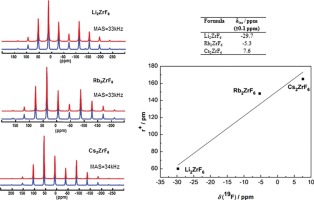Ask for a reprint
email :
* Give your email
2018
ACL
|
Aydar Rakhmatullin, Miroslav Boča, Jarmila Mlynarikova, Eva Hadzimova, Zuzana Vaskova, Zuzana Netriová, Ilya Polovov, Matej Micusik, 'Solid state NMR and XPS of ternary fluorido-zirconates of various coordination modes', J. Fluorine Chem. 208 24-35 (2018) doi:10.1016/j.jfluchem.2018.01.010
Extended information is provided about 19F MAS NMR and XPS spectroscopic data on 11 ternary fluorido-zirconates (Li2ZrF6, Rb2ZrF6, Cs2ZrF6, Na3ZrF7, (NH4)3ZrF7, K3ZrF7, Li4ZrF8, K2ZrF6, Na5Zr2F13, Na7Zr6F31, and (NH4)2ZrF6), which display different coordination numbers of the zirconium atom as well as different modes of fluorine atom bonding. XPS data show that binding energies on fluorine 1s electrons are sensitive to its coordination properties (ionic, terminal or bridging coordination mode) while the binding energies of zirconium orbitals are not sensitive to its coordination properties (six-, seven- or eightfold coordination). 19F chemical shifts correlate with the ionic radii of counter cations along the series Li2ZrF6, Rb2ZrF6, Cs2ZrF6 and K3ZrF7, (NH4)3ZrF7 and Na3ZrF7. This reflects the polarizability properties and shielding potential of the cations surrounding the fluorine atoms. Additionally, calculations of NMR parameters for the compounds were also carried out using the CASTEP DFT code. The correlation between the experimental isotropic chemical shifts and calculated isotropic chemical shieldings established for the studied compounds allows us to predict the 19F NMR spectrum of crystalline compounds with good accuracy. A unique technique of low temperature 19F MAS NMR experiments combined with CASTEP calculation on (NH4)2ZrF6 enabled the assignment of all 12 crystallographically non-equivalent fluorine atoms to NMR signals.
|

|